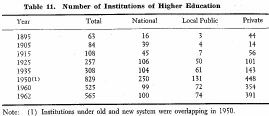| Home > Policy > White Paper, Notice, Announcement > White Paper > JAPAN'S GROWTH AND EDUCATION 1963 > CHAPTER |
||
The number of institutions of higher education has been increasing
steadily. After 1918, universities and colleges increased rapidly. Again, after
World War ![]() ,
universities increased greatly as the result of the educational reform.
,
universities increased greatly as the result of the educational reform.
There had been a systematic establishment of national institutions of higher education since the beginning of the Meiji Era, starting from Tokyo and gradually expanding to other places, by dividing the country into several blocs. After 1918, colleges were increased and each of the 46 prefectures came to have at least one college. This principle had been observed until the post-war educational reform, under which at least one university was established in each prefecture.
Public institutions of higher education also increased greatly immediately after 1918.
As private institutions, only colleges were recognized up to
1918. After that, private universities were recognized and the number increased.
In 1960, about two thirds of the total number of national, local public and private
higher educational institutions were private institutions. 60 per cent of all
private institutions of higher education are of junior college level. Most of
the private institutions have been located in cities, particularly in the largest
cities since World War ![]() .
.

| Back to Top | MEXT HOME |